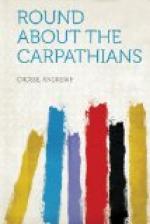On leaving this place the road immediately begins to ascend the mountain, and may be described as a sort of pass over a spur of the Carpathians. It was a very beautiful drive, favoured as we were, too, with fine weather. The road on the northern side is even well made, ascending in regular zigzags. After gaining the summit, we left the post-road that we had hitherto traversed, and took our way to the right, descending through a forest. The varied foliage was very lovely, and the shade afforded us most grateful. It was an original notion driving through such a place, for, according to my ideas, there was no road at all; but H——, more accustomed to the country, declared it was not so bad, at least he averred that there were other roads much worse. The jolting we got over the ruts and stones exceeded anything in my previous experience. How the cart kept itself together was a marvel to me, but it accommodated itself by a kind of snakelike movement, not characteristic of wheeled vehicles in general. Except for the honour and glory of driving, I would as lief have walked, and I think have done the journey nearly as soon; but my friend observed, “It was no good giving into bad roads down in this part of the world.”
At one of the worst turnings we met several bullock-carts filled with iron pyrites from the copper-smelting. The custom of the drivers of these carts is to stop at the bottom of a steep bit of hill, and then put five or six pairs of oxen to draw up one cart. The process is a slow one, but is better for the oxen. We had great difficulty in passing in safety, for unluckily at the spot we met them the trees were so thick that they literally walled up the road, and on the other side there chanced to be a very uninviting precipice, and of course we had the place of honour.
Soon after this little excitement was over we came upon a fine view of the Danube, with a long stretch of Servian forests beyond. On we jolted, till at length New Moldova was reached: this place has smelting-furnaces, and in the neighbourhood are extensive copper mines. The district is known as the Banat of Temesvar, an extensive area of the most fertile land in Europe; rich black soil, capable of growing any number of crops in succession without dressing. This part of Hungary supplies the finest white flour, so much esteemed by the Vienna bakers, and now sought after by the pastrycooks in England.
There was a fair going on at New Moldova, which afforded me an opportunity of seeing the peasants in their gala dresses. The place is renowned for its pretty Wallack girls, and I certainly can bear witness that I saw not a few handsome faces. But what struck me most was the graceful movements of these damsels: their manner of walking was the very poetry of motion. I daresay it was the more striking to me because I had recently come from England, where fashion condemns the wearers of high-heeled shoes to a rickety waddle! Even here, in these wilds, fashion maintains a despotic rule. I understand black hair is the thing at present, so every Wallack maiden dyes her hair to the regulation colour, though Nature, who never makes a mistake, may have matched her complexion with auburn locks.




